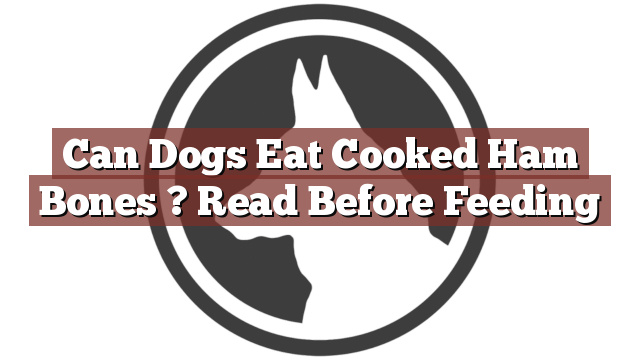Understanding Your Dog’s Dietary Needs
As a responsible pet owner, it is crucial to understand your dog’s dietary needs to ensure their overall health and well-being. While dogs are primarily carnivorous animals, their diet should consist of a balanced combination of protein, carbohydrates, fats, vitamins, and minerals. It is important to feed them a nutritionally complete diet that meets their specific requirements.
Can Dogs Eat Cooked Ham Bones? Read Before Feeding
Can dogs eat cooked ham bones? This is a question that often arises among dog owners. The answer is no. Although dogs have a natural instinct to chew on bones, it is important to know that certain bones can pose serious risks to their health. Cooked ham bones, in particular, can be dangerous for dogs.
Cooked bones, such as those found in ham, can splinter easily when chewed. These sharp fragments can cause serious injuries to a dog’s mouth, throat, and digestive system. They can lead to choking, lacerations, blockages, or perforation of the intestines. Therefore, it is best to avoid feeding your dog cooked ham bones to prevent any potential harm.
Pros and Cons of Feeding Cooked Ham Bones to Dogs
It is essential to weigh the pros and cons of feeding cooked ham bones to your dog before making any decisions. One potential benefit is that chewing on bones can help promote dental health. The act of gnawing can help remove plaque and tartar buildup on your dog’s teeth. However, this can be achieved through safer alternatives, such as specially designed dental chews or toys.
On the other hand, the risks associated with feeding cooked ham bones to your dog outweigh any potential benefits. The danger of bone splintering and causing harm to your pet’s digestive system is significant. It is not worth risking your dog’s health for the sake of a chew toy. Instead, opt for safer alternatives that provide similar benefits without the risks.
Conclusion: Weighing the Risks and Benefits of Feeding Cooked Ham Bones to Your Dog
In conclusion, it is important to prioritize your dog’s safety and well-being when considering their dietary options. Can dogs eat cooked ham bones? The answer is a resounding no. The potential risks of feeding cooked ham bones to your dog far outweigh any potential benefits. These bones can splinter easily and cause serious injuries to your pet’s mouth, throat, and digestive system.
If you are looking for safe alternatives to provide your dog with something to chew on, consider specially designed dental chews or toys that promote dental health without the risks associated with bones. Always consult with your veterinarian to ensure that you are providing your dog with a nutritionally balanced diet that meets their specific dietary needs.
Thank you for taking the time to read through our exploration of [page_title]. As every dog lover knows, our furry friends have unique dietary needs and responses, often varying from one canine to another. This is why it's paramount to approach any changes in their diet with caution and knowledge.
Before introducing any new treats or making alterations to your dog's diet based on our insights, it's crucial to consult with a veterinarian about [page_title]. Their expertise ensures that the choices you make are well-suited to your particular pet's health and well-being.
Even seemingly harmless foods can sometimes lead to allergic reactions or digestive issues, which is why monitoring your dog after introducing any new food item is essential.
The content provided here on [page_title] is crafted with care, thorough research, and a genuine love for dogs. Nevertheless, it serves as a general guideline and should not be considered a substitute for professional veterinary advice.
Always prioritize the expert insights of your veterinarian, and remember that the health and happiness of your furry companion come first.
May your journey with your pet continue to be filled with joy, love, and safe culinary adventures. Happy reading, and even happier snacking for your canine friend!

